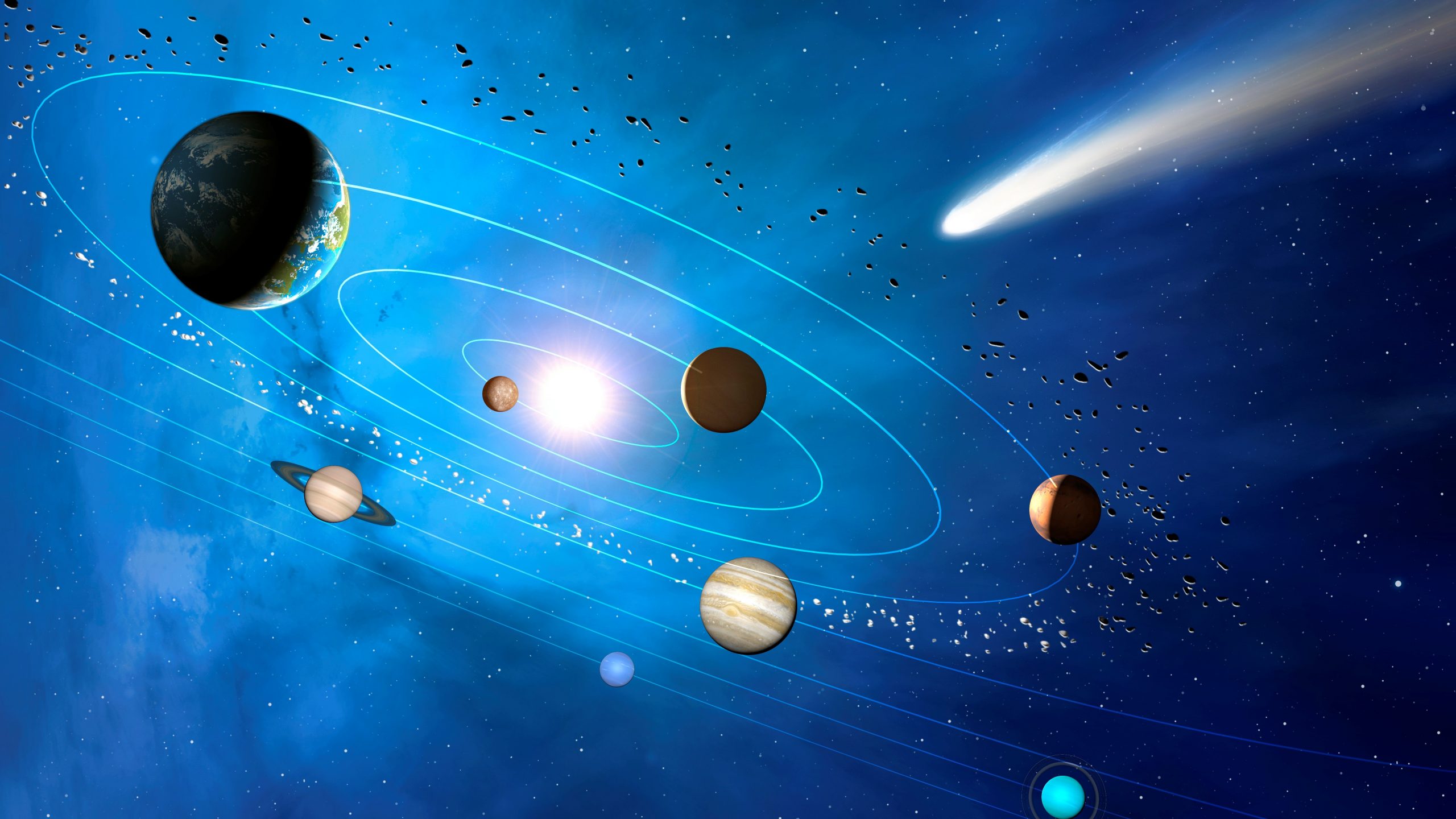Here are the planets in the solar system listed in order of their distance from the Earth, along with a brief description of each:
- Mercury:
Distance from Earth: Varies between approximately 77 million kilometers (48 million miles) and 222 million kilometers (138 million miles) due to its elliptical orbit.
Mercury is the closest planet to the Sun and the smallest planet in the solar system. It has a rocky surface and no atmosphere to speak of, which makes it extremely hot during the day and freezing cold at night. It completes an orbit around the Sun in about 88 Earth days.
- Venus:
Distance from Earth: Varies between approximately 38 million kilometers (24 million miles) and 261 million kilometers (162 million miles) due to its elliptical orbit.
Venus is the second planet from the Sun and often referred to as Earth’s “sister planet” due to its similar size and composition. It has a thick atmosphere primarily composed of carbon dioxide, which creates a greenhouse effect, making it the hottest planet in the solar system. Venus has a slow rotation, taking about 243 Earth days to complete one day-night cycle.
- Mars:
Distance from Earth: Varies between approximately 55 million kilometers (34 million miles) and 401 million kilometers (249 million miles) due to its elliptical orbit.
Mars, often called the “Red Planet,” is the fourth planet from the Sun. It has a thin atmosphere mainly composed of carbon dioxide. Mars is known for its reddish appearance due to iron oxide (rust) on its surface. It has polar ice caps and evidence of past liquid water, making it a target for the search for extraterrestrial life. Mars has a day length similar to Earth, with a Martian day lasting about 24 hours and 37 minutes.
- Jupiter:
Distance from Earth: Varies between approximately 588 million kilometers (365 million miles) and 968 million kilometers (601 million miles) due to its elliptical orbit.
Jupiter is the largest planet in the solar system and the fifth planet from the Sun. It is a gas giant with a thick atmosphere primarily composed of hydrogen and helium. Jupiter is known for its prominent bands of clouds and its iconic Great Red Spot, a giant storm system. It has a strong magnetic field and a large number of moons, including the four Galilean moons: Io, Europa, Ganymede, and Callisto. Jupiter completes one orbit around the Sun in about 12 Earth years.
- Saturn:
Distance from Earth: Varies between approximately 1.2 billion kilometers (746 million miles) and 1.7 billion kilometers (1 billion miles) due to its elliptical orbit.
Saturn is the sixth planet from the Sun and is famous for its stunning ring system made up of icy particles and debris. It is a gas giant, similar in composition to Jupiter, with a thick atmosphere. Saturn has numerous moons, with its largest moon, Titan, being of particular scientific interest due to its dense atmosphere and presence of lakes and rivers of liquid methane. Saturn takes about 29.5 Earth years to complete one orbit around the Sun.
- Uranus:
Distance from Earth: Varies between approximately 2.6 billion kilometers (1.6 billion miles) and 3.2 billion kilometers (2 billion miles) due to its elliptical orbit.
Uranus is the seventh planet from the Sun and is an ice giant. It has a unique feature—an extreme tilt of its rotational axis, which causes it to appear to roll on its side. Uranus has a predominantly hydrogen and helium atmosphere with traces of methane, which gives it a blue-green color. It has a system of rings and numerous moons. Uranus completes one orbit around the Sun in about 84 Earth years.
- Neptune:
Distance from Earth: Varies between approximately 4.3 billion kilometers (2.7 billion miles) and 4.7 billion kilometers (2.9 billion miles) due to its elliptical orbit.
Neptune is the eighth and farthest planet from the Sun. It is also an ice giant, similar in composition to Uranus. Neptune has a deep blue color due to the presence of methane in its atmosphere. It has a dynamic atmosphere with high-speed winds and a prominent dark spot called the Great Dark Spot (similar to Jupiter’s Great Red Spot). Neptune has a system of rings and a collection of moons, with its largest moon, Triton, being notable for its retrograde orbit. Neptune takes about 165 Earth years to complete one orbit around the Sun.
These descriptions provide a general overview of the planets in the solar system. Each planet has its own unique characteristics and features that make it intriguing for scientific exploration.
